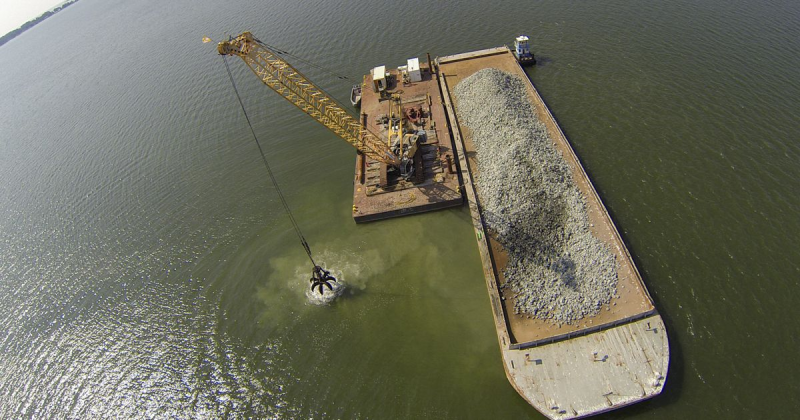Efforts to restore healthy oyster reefs in 10 Chesapeake Bay tributaries are making significant progress toward regional goals (PDF, 15 pages). The work to restore more than 2,300 acres is the world’s largest oyster restoration project. The experts who make the restoration happen tally their results at the end of each year. Efforts have now surpassed 2 square miles of healthy oyster reef habitat.
NOAA leads teams working in Maryland and Virginia waters to restore oyster reefs. We work with the U.S. Army Corps of Engineers, state agencies including the Maryland Department of Natural Resources and Virginia Marine Resources Commission, and numerous nonprofit and academic partners.
Restoration Is Critical
Oysters grow in reefs that provide habitat for many Chesapeake Bay species. For example, juvenile blue crabs and some fish like to hide from predators in between oysters. Other living resources like to spend time in and near oyster reefs, too. They often find food in those areas. That makes oyster reefs good places for both commercial and recreational fishermen to target their efforts. And oysters are filter feeders, so they help clean the water as they eat.
But oyster populations in the Chesapeake Bay are much lower than they used to be. As a result of disease, overfishing, degraded water quality, and other problems, only about 3 percent of the historic native oyster population remains. That means the ecosystem and economic benefits oyster reefs provide have diminished, too.
That’s why NOAA and partners have come together through the Chesapeake Bay Program to work on restoring oysters. They have selected 10 tributaries—five each in Maryland and Virginia. In each tributary, scientists first evaluate where restoration would work best. They develop a “restoration plan” to guide the work, which can include building a reef base out of hard substrate and/or seeding an area with baby oysters (known as spat-on-shell). After the restoration work, we monitor the restoration areas to track their progress.
Making Good Restoration Progress
So far, seven of the 10 tributaries that were chosen for restoration work have been completed. Still remaining are the Manokin River in Maryland and the Lynnhaven and lower York rivers in Virginia. In-water restoration work in the lower York is almost done. The Virginia Marine Resources Commission plans to complete work in that river by the end of this year.
Restoration work has already been completed in Harris Creek and the Little Choptank, Tred Avon, and St. Mary’s rivers in Maryland and the Lafayette, Piankatank, and Great Wicomico rivers in Virginia. And a few years ago, Virginia decided to restore oysters in an additional river. The Eastern Branch of the Elizabeth River has been completed and is considered a “bonus” tributary!
The partners plan to finish restoring the 10 tributaries by 2025. Because 2025 is coming soon, they are already thinking about what comes next. Plans are still in the works, but future restoration will likely seek to incorporate elements of restoration, aquaculture, and the wild oyster fishery.


